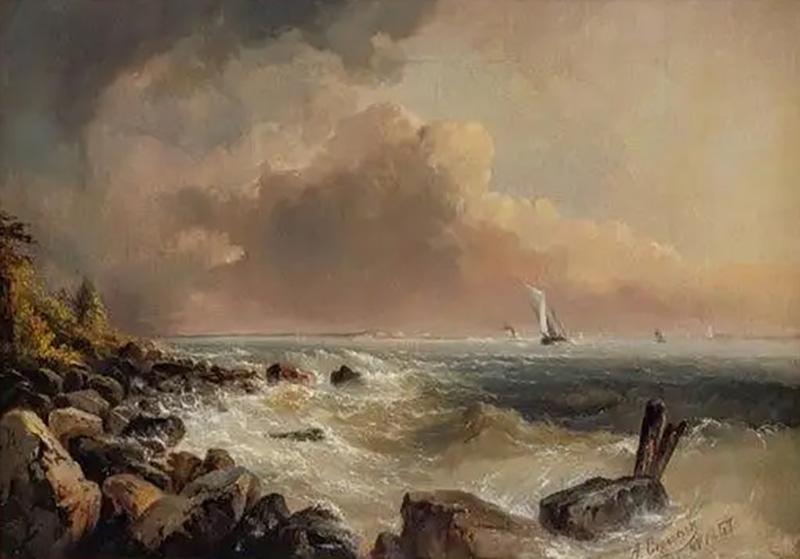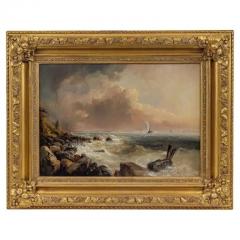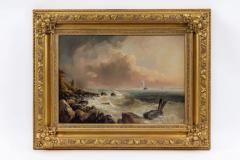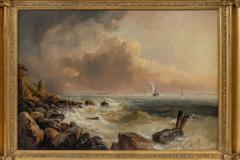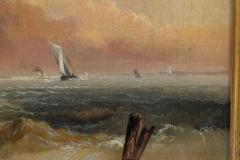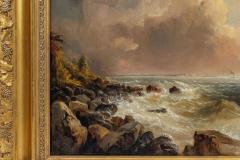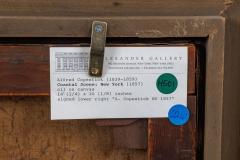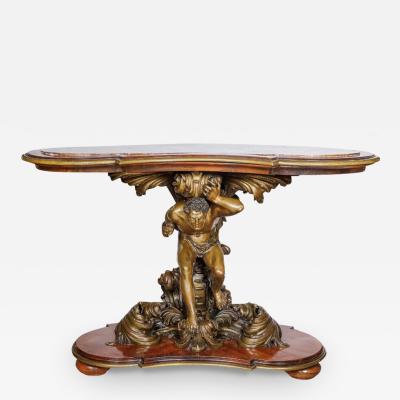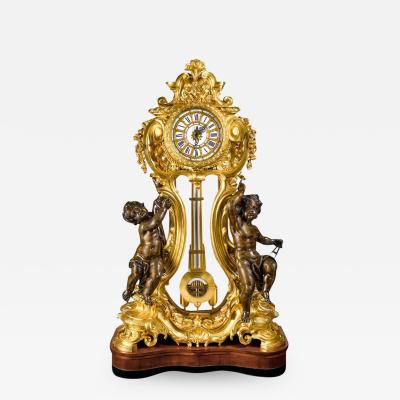Alfred Copestick, Coastal Scene: New York, Oil on Canvas, 1857 1857
-
Description
Alfred Copestick (1837–1859)
Coastal Scene: New York, 1857
Oil on canvas, in the original giltwood frame
14 ¼ x 20 ⅛ in. (canvas)
Signed lower right: A. Copestick NY 1857
Painted at just twenty years of age, Coastal Scene: New York demonstrates Alfred Copestick’s remarkable promise as a marine painter in antebellum America. The scene brims with energy: a single sailboat heels sharply into the wind, its rigging taut against the storm, while foamy waves break against a rugged shoreline. Above, clouds mass and dissolve, illuminated by shafts of storm-lit light. Copestick’s treatment is both romantic and naturalistic, conveying the sublime tension between man, sea, and sky. His confident brushwork captures atmosphere with an immediacy and sensitivity rarely found in so young an artist.
The work survives in its original giltwood frame, richly carved in a mid-nineteenth-century American style, which not only underscores its historical authenticity but also heightens the tonal drama of the painting.
Alfred Copestick came of age during a fertile moment in American painting, when marine art and landscape were central to cultural identity. Though little is known of his formal training, his works suggest familiarity with and admiration for leading marine painters such as James E. Buttersworth, famed for his racing yachts; Francis Augustus Silva, who later developed a luminist style of coastal painting; and earlier masters like Thomas Birch, whose shipwrecks and storm scenes set a precedent for drama at sea.
Copestick also absorbed broader currents in American landscape painting. The Hudson River School, led by Thomas Cole, Asher B. Durand, and later Frederic Edwin Church, emphasized sublime nature and sweeping skies, themes that resonate strongly in Copestick’s skies and coastal atmospheres. In his harbor and coastal subjects, one can sense inspiration from John F. Kensett and Fitz Henry Lane, painters who balanced luminous stillness with maritime precision.
Although his career ended too abruptly for him to form a circle of followers, Copestick’s promise was acknowledged by critics of the day, who referred to him as “a young man of rare promise.” Had he lived longer, he might well have joined the ranks of these canonical figures, bridging marine detail with luminist clarity.
Alfred Copestick was born in New York in 1837. By his late teens he was already producing ambitious canvases, and by 1857 he had signed and dated works depicting Fort Hamilton from the Narrows, New York and Coastal Scene: New York. In 1858 he completed his best-known painting, New York from the Harbor Showing the Battery and Castle Garden (now in the collection of The Metropolitan Museum of Art, New York), a work that situates him firmly within the city’s art circles. That same year he began exhibiting at the National Academy of Design, where his works received critical notice.
Tragically, in August 1859, while visiting his father in Delmar Township, Pennsylvania, Copestick suffered a fatal accident when a hunting rifle discharged. He was only twenty-two years old. His premature death silenced a voice that was just beginning to find expression and left behind a body of work so small that every surviving canvas is of great rarity and importance.
Institutional References: The Metropolitan Museum of Art, New York – New York from the Harbor Showing the Battery and Castle Garden, oil on canvas, 1858 (acc. no. 54.90.89).
National Academy of Design, New York – Copestick exhibited several marine subjects during the late 1850s.
Other known works include Fort Hamilton from the Narrows, New York (1857) -which we are also currently offering for sale - and Coney Island, New York (1857), both formerly handled by Alexander Gallery.
Coastal Scene: New York stands as one of the most evocative survivals from Copestick’s short career. The painting not only embodies the drama of mid-nineteenth-century marine art but also testifies to a prodigy whose artistic life was cut tragically short. It belongs to the same rare lineage as his Fort Hamilton view and the celebrated harbor scene at The Met.
This painting is a museum-worthy canvas: a work of youthful genius, steeped in the traditions of American Romantic and luminist painting, and preserved in its original frame. For collectors of American marine art, it represents both an aesthetic triumph and a poignant reminder of the promise and fragility of nineteenth-century artistic lives.
Other known works include Fort Hamilton from the Narrows, New York (1857) -which we are also currently offering for sale - and Coney Island, New York (1857), both formerly handled by Alexander Gallery.
Provenance:
Alexander Gallery, Madison Avenue, New York
Canvas: 14 ¼ x 20 ⅛ in.
Frame: 22" high x 28" wide
Very good condition. Ready to hang. -
More Information
Documentation: Signed Origin: United States Period: 1900-1919 Materials: Canvas,Oil Condition: Good. Creation Date: 1857 Styles / Movements: Other Incollect Reference #: 823440 -
Dimensions
W. 28 in; H. 22 in; W. 71.12 cm; H. 55.88 cm;
Message from Seller:
For four generations, Solomon Treasure has built a distinguished reputation for offering rare and important 18th-19th century antiques and fine art, serving museums, collectors, and designers worldwide. Located in the heart of Manhattan, we specialize in exceptional pieces ranging from Napoleon Neoclassical to Art Deco and Middle Eastern Islamic treasures. Contact: Mory Talasazan, Director | mory@solomontreasureny.com | 917.686.9732 |















